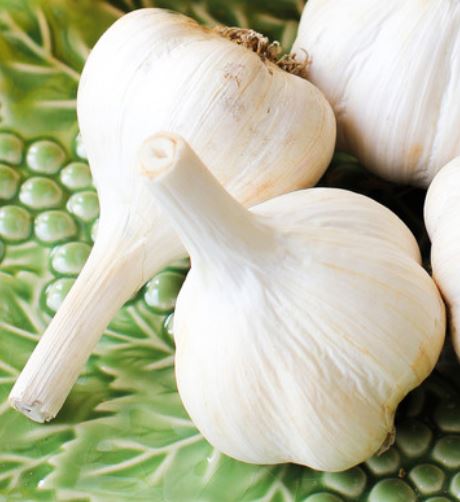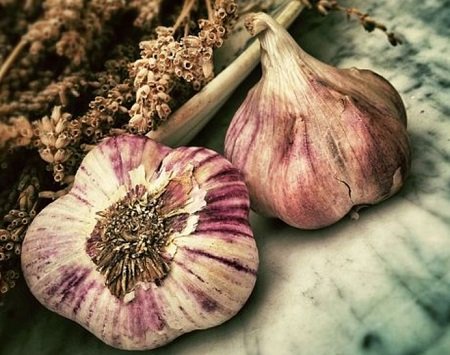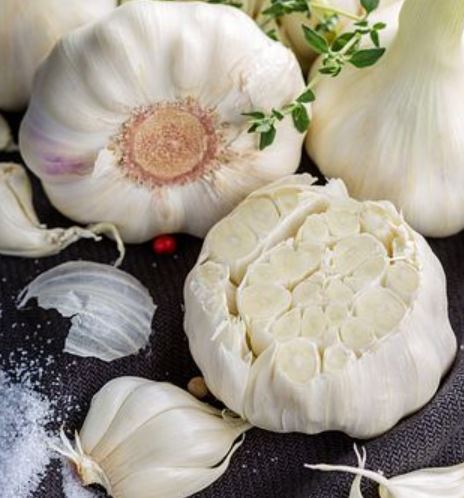Many home gardeners have started to adopt the action of growing vegetables from the comfort of home. But before you start this endeavor, let us help you understand which types of garlic are most suitable for you to grow and what are the requirements to be met.
Garlic culturing is thought to have an origin in Asia where the weather conditions are cold winters and warm springs. Many garlic variants still prefer these weather conditions and this is why they are the most ideal conditions to grow garlic on a mass scale.
In order to ascertain a good crop of garlic, you must be aware of the different varieties and which one suits your garden conditions.
Garlic goes by the scientific name Allium sativum, it belongs to the genus Allium which is the same family that onions, shallots, and spring onions belong to. There are two Galic species Sativum (hard neck) and Ophioscorodon (soft neck) that are further divided into multiple subspecies.
Hardneck garlic
The Hardneck garlic species refers to all garlic varieties that have hard stalks. It has a central stalk around which the garlic cloves grow. Expect hardneck garlic to provide fewer cloves compared to softneck garlic variants.
Harvesting for hardneck garlic occurs in late summer when most leaves have turned brown and dry.
Below are popular hardneck garlic variants
Growing Porcelain Garlic

This hardneck variety features an enlarged garlic bulb in which only 4 to 7 cloves are present on a single garlic head.
In comparison to other garlic variants, the Porcelain garlic type is known for an extremely hard outer covering. This hardy outer skin makes it an excellent garlic type for storing for later use. They are easy to peel and have a rich taste.
Porcelain garlic is best suited for well-drained soil and tends to do well in most climates, except extremely hot climates such as those found in Texas, Florida, and California.
Use the largest Porcelain garlic bulbs and cloves if you want a good harvest. Place them in 2-inch-deep holes. Put a 3 to 4-inch layer of mulch on the areas after the ground freezes. You can use a straw for this since it provides the best safety for the garlic plant.
Core seasons such as late spring and early summer call for a 1-inch-high water supply. If you are experiencing rain, do not water the garlic.
Another point to be cautious about is weeds, remove them on sight since they steal nutrients and deprive the garlic plant.
Examples of Porcelain Garlic: Iowa German White, Romanian Red, Georgia Fires, German Extra Hardy, Leningrad
Growing Rocambole Garlic

Rocambole is the most common form of hardneck garlic. You will find many chefs that call all hardneck garlic Rocambole.
Their outer covering resembles a white paper-like substance that is not as hard as softneck garlic outer layers. Throughout the world, this cold-resistant garlic type is renowned for its strong and intense flavor.
Because the skin is not too thick, it can be peeled easily. But this also results in shorter shelf life.
Fortunately, this type of garlic is also known to give curly stems called scapes. Due to the appearance of the scapes, they are often called “serpent” garlic.
These scapes can become flowers that offer seeds that can be used to grow garlic. Sadly, this takes too much time compared to just planting cloves.
Scapes themselves are edible shoots that offer a great taste to any dish they are used in. A popular type of Rocambole garlic is the “Spanish Roja” garlic.
Rocambole garlic thrives in cold climates and does not do well in warmer climates. It is not the easiest garlic variant to grow but the flavor is well worth the efforts!
Using good quality cloves, they require well-draining soil that has nutrients incorporated into it.
The pH should fall in the range of 6.0 to 7.0 where 6.5 is the optimal pH. Plant them around 1 to 2 weeks before the ground freezes for winter.
Cloves should be 4 to 6 inches apart from each other while rows should have a 12 to 18 inch spacing. Mulching is vital after planting to hold off the snow.
This garlic will form a root system during fall and winter. The sunny spring season will provide a growth spurt. During the mid-season, the garlic will accelerate growth if provided with compost or blood meal fertilizer.
Examples of Rocambole Garlic: Chesnok Red, German White, Persian Star, Polish Hardneck
Growing Purple Stripe Garlic

As the name suggests, Purple Stripe garlic has a characteristic purple color with stripes of varying color intensity and their wrapping also displays blotches of color.
Temperatures where it is grown influence the skin color. They can be bright or dull purple shades. Expect this variant to yield 8 to 12 cloves on each garlic bulb.
Purple Stripe garlic should be planted in the fall before the ground freezes, therefore planting 4 to 6 weeks in advance is a must.
Take the healthiest and largest bulbs and plant them in holes that are 1 to 2 inches deep. Choose manure that consists mainly of composted organic materials.
Plant them with 5 to 6 inches between each clove. Place each clove with the pointed portion facing upwards. After planting, cover the area with mulch (straw or leaves) as this protects from winter freezing.
As shoots appear, remove the mulch. You can opt to leave a thin layer of mulch if you notice the weather is still cold.
In spring, you can start to fertilize the garlic with an interval of one month. Water only when the topsoil looks dry. Stop all watering efforts towards the last few months while cloves are developing.
Examples of Purple Stripe Garlic: Belarus, Metechi, Siberian, Russian Giant Marble, Purple Glazer, Starlight
Softneck Garlic
Softneck garlic is the dried-out type that you find for sale in most shops. They keep well for many months at a time. They are appropriate for warmer climates and mature at a faster rate than hardneck garlic.
This type of garlic does not form scapes and is bound to have many more cloves per head.
Popular subspecies of Softneck Garlic are Artichoke and Silverskin garlic.
Growing Artichoke Garlic

This garlic type is named “Artichoke” as it bears the same overlapping multi-layer appearance of the artichoke vegetable. The Artichoke variant bears up to 12-20 cloves on a single garlic plant. (This is still less than Silverskin garlic.)
Due to their hard outer layer, they are difficult to peel but at the same time can be stored for a longer time. They can last 8 months when left unpeeled and cured. They have a white to cream-colored outer layer.
These variants do not produce flowering stems (scapes) but are relatively easy to grow. Their outer covering usually bears spots or stripes.
Artichoke garlic is best grown in the Southern areas of the USA like California as they have mild winters. Select well-draining “crumbly” soil situated in full sunlight to plant your garlic. You will be required to add composted materials to this well-tilled soil before planting the cloves.
Plant them 1 to 3 inches deep with 6 inches between cloves, rows need a space of 12 to 14 inches apart from each other.
After planting, roots will develop rapidly. A dormant period will follow and then a vegetative growth and lastly development of cloves in the bulb.
They require a constant supply of water but not waterlogged conditions. Stop watering after the leaves change color and become dry.
Examples of Artichoke Garlic: California Late, California Early, Polish Red, Applegate, Early Red Italian, Red Toch
Soil Requirements of Garlic – Which soil is best for Garlic Growing?
Growing Silverskin Garlic

The Silverskin garlic features a layered structure like Artichoke garlic.
They have the longest storage life and are the easiest to grow in a variety of climates providing the highest yields. Thus they are the most common type of fresh garlic on grocery store shelves.
Expect each garlic head to possess 14 to 24 cloves in an oblong shape. The cloves carry a certain reddish hue.
A tight skin surrounds the clove protecting the garlic within the wrapping. Their stems are usually soft and are easy to craft into a braid while storing and curing.
Their skins are white but some say they resemble a silver papery appearance.
Silverskin garlic can adapt to a range of climates. This means that they grow in a range of zones in America. You should plant them between September and November if you live in cooler conditions.
They prefer loamy soil with a slightly acidic to neutral pH level. Be sure to plant them in an area that receives a large amount of sunlight for the longest possible time.
Plant them in 2-inch holes and place cloves no less than 2 to 4 inches apart. Rows should have an inter-row spacing of 10 to 14 inches between them.
Examples of Silverskin Garlic: Polish White, Italian Red, Kettle River Giant
Elephant Garlic
Elephant garlic might appear like enlarged garlic but it is not part of the garlic group. It is closer in relation to leeks than to garlic. It is a perennial plant.
This plant tastes milder compared to the traditional strong and pungent flavor of real garlic.
Growing Elephant garlic in complete sunlight will give large bulbs whereas growth in partially shaded areas yields smaller bulbs.
You can grow this variety in spring. It will be ready to harvest in just 90 days but it will only develop a single large bulb. Fall-grown garlic can be harvested after 8 months during the summer season.
Soil should have a pH of 6 to 7 and must be easy to drain, add compost prior to planting to ensure retention of moisture.
Divide the bulb and plant the cloves 4 to 6 inches deep. Space each clove at 8 to 12 inches apart to breathe. Water with 1 inch of water regularly. This variant develops scapes that are edible. You can remove scapes before they become flowers and use them in your food.
As soon as leaves turn yellow or brown, harvesting must take place. Harvesting is not the end, take the bulbs and shake them to allow drying in the shade for a few days.
Do not let water encounter the bulbs or it can induce rot. If you want to store your bulbs, curing is a mandatory process that you cannot ignore. Remove 1 inch of the stems and the roots.
Store them at 45 to 55 Fahrenheit in limited humidity. This assures they can last for 8 to 10 months; we advise using them in 3 to 4 months.
Conclusion
When choosing the right garlic for you, there are certain aspects to consider first. These include:
- Soil types
- Weather
- Garlic use or requirements
- Space
- Sunlight
Garlic as a vegetable has garnered fame everywhere for its unique yet potent flavor. Used as a tastemaker in just about any dish, garlic is a common element in any kitchen. It is understandable why people would love to grow this vegetable in their garden.
Looking at the above aspects, you can choose the garlic type that will do best in your garden to assure a fruitful harvest of garlic.

